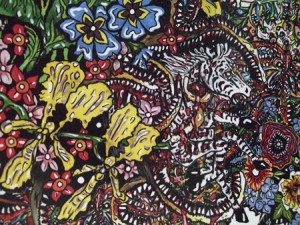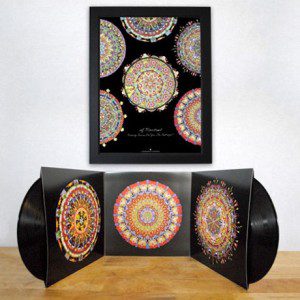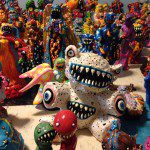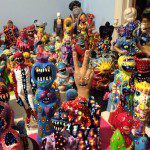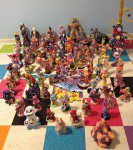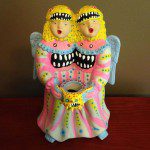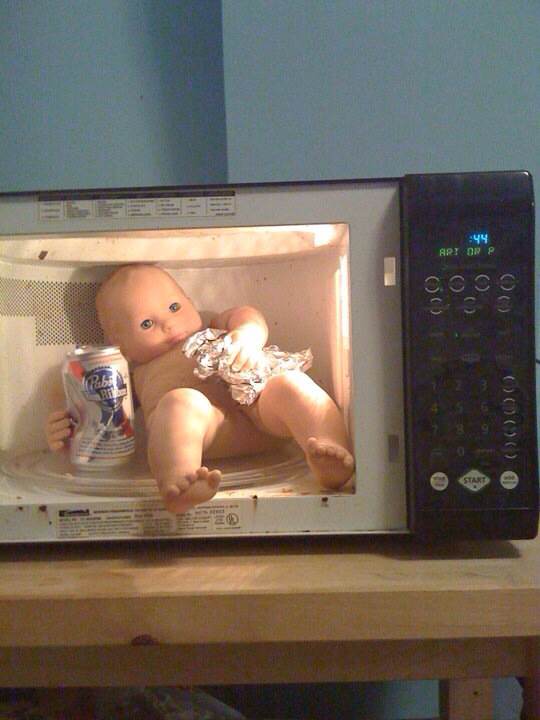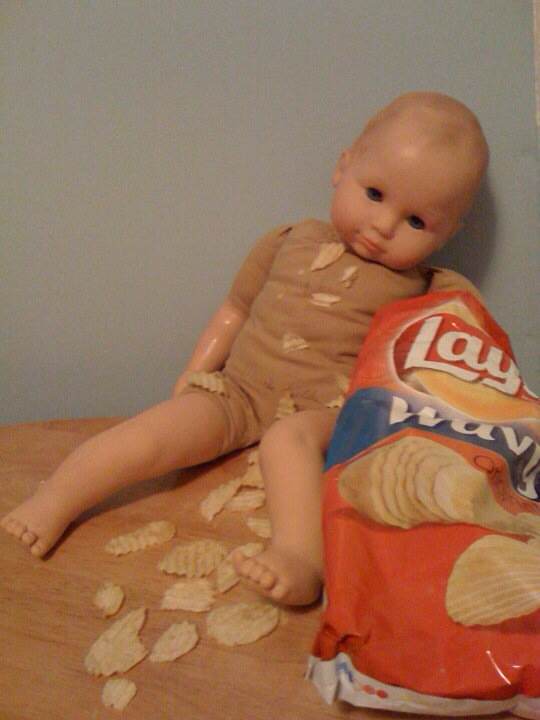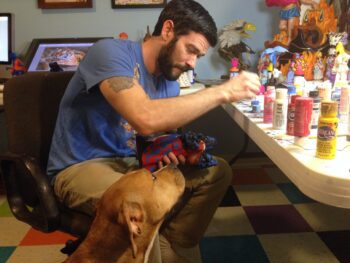
Welcome back to Sound & Vision, the Rumpus profile series that spotlights the creative talents of those working behind the scenes in the music industry. Indie pop, vaudeville funk, glam, and electronica—over the years of Montreal has managed to master each of these genres in pursuit of its own grand creative vision. I’ve always been fascinated not only by the band’s music, but also its incredible album art and elaborate stage shows. These visual feasts are the work of the multimedia artist and performer David Barnes, brother of the band’s frontman Kevin Barnes.
From 1998’s The Gay Parade on, David has been responsible for bringing of Montreal’s distinctive visual aesthetic to life. His innovative album art has gone far behind the sleeve to include collectible cassette covers, posters, and even a board game. In 2008 the album Skeletal Lamping was released in no less than ten different formats, including a conventional CD and vinyl, as well as t-shirts, button sets, wall decals, tote bags, and a paper lantern with embedded download codes. David has also designed videos and animations, costumes, props, and sets for of Montreal’s live performances, and in 2011, he published the book ¿What’s Weird?, a twenty year retrospective of his paintings and sketches. David is currently touring with of Montreal and designing the visuals for the band’s forthcoming spring album. He spoke to me about his life and work, and why—perhaps more than ever—it’s important to create art that brings people together.
***
The Rumpus: Can you tell me a little about your early artistic influences?
David Barnes: Every little kids draws, and then some people just stop drawing. You can see it in adults where at some point someone said to them, “You draw like a twelve-year-old,” and that’s when they stopped drawing. But some people continue, for some reason. And for me that was because whenever my aunt would come over she would always be like, “Oh, it’s time to draw,” and afterwards she would look at it and pay attention to the details, like, “Oh, there’s a mountain goat on top of the mountain!” When you get praise like that when you’re young, you like it and you say, “Oh, okay, I’m going to do more of that!” If eventually the mountain goat on top of the mountain wouldn’t get that response anymore, then maybe I’d say, “Okay, I’m putting an alien at the bottom.” She kept encouraging me to do new things.
Rumpus: When did you first consider pursuing art as a career?
Barnes: When I was little drawing was like playing with toys for me. If I was by myself I would make studios in closets by taking everything out of there and just holing up. But it was really my brother Kevin, when he started taking music more seriously, who turned me onto the idea that making art was something to take seriously.
Rumpus: So from the start, did you two think of making art as a collaborative enterprise?
Barnes: We were so close it was just like logic. In the very beginning it was more like he would just see a painting I made and he’d be like, “Let’s use that one!” but very quickly we started getting more in-depth, more into it. And he was writing songs that were very pictorial, that had a story. Around the time of The Gay Parade—that was the first album where I just drew all these characters. I was about eighteen or nineteen at the time, that time in life where you’re searching for a purpose, and he and I would focus on this one project and make it the most important thing in the universe. It was great!
Rumpus: Over the years, your artwork has always managed to capture the essence of what’s happening musically for of Montreal. When you design a particular album, are you thinking more about the specific themes of that record or the discography from the beginning to the present?
Barnes: It always feels to me like a brand new project. It’s actually funny that we’re talking about this right now because I’m in the very beginning stages of designing artwork for the new album. I’m listening to the demos and trying to see what it looks like. Images pop into my head and I’ll be like, “Hmm. Maybe. No. Maybe it’s this one? Could be. Yes! That’s the one.” Sometimes it’s almost like in Mad Men when [Don’s] in his office and he’s lying on the couch and it looks like he’s just sleeping, but in his mind the final product is formulating. At first it’s all inside your mind and you’re just going with your gut. Then you have to decide what direction is worth pursuing.
Rumpus: Is part of the challenge that you’re not just coming up with a visual representation of the music, but something more like an aesthetic sense?
Barnes: It’s important to put that weight on it. You have to feel like it’s very, very important. You know that nervous feeling you get before you do anything that’s really big, that feeling that you can’t fail. You have to work through that to get to the point where you can make something that feels big, feels like it could last forever, that it could be that important.
Cover for Icons, Abstract Thee (left) and detail from Skeletal Lamping (right)
Cover/inside sleeve for Hissing Fauna, Are You The Destroyer?
Rumpus: How did you come up with the concept for Skeletal Lamping?
Barnes: It’s always meant so much to Kevin and me to have this visual representation of the music, and to have a package that makes it so much more visceral, so much more real. You can play the record and hold this thing, and look at it, and take it in on all of these different sensory levels. When we started it was CDs, and CDs are small—and then things were reduced to thumbnails because people were using digital files, like mp3s, and it felt like artwork wasn’t even going to be a factor anymore. With Skeletal Lamping we really wanted to do something that, even when confined to the CD package, you could hold up and fold out, and that would force you to look at this thing, and it would become bigger that way. 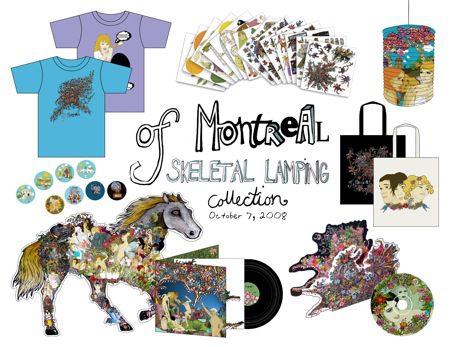 So we made it into a sculpture! The big challenge was to make something fit into those small parameters. It was really just an attempt to get back, to imagine what people felt in the 50s or the 70s when they had to search for a record, and when they found it, and listened to it, and held it, it was special. It was something they were going to take care of and treasure.
So we made it into a sculpture! The big challenge was to make something fit into those small parameters. It was really just an attempt to get back, to imagine what people felt in the 50s or the 70s when they had to search for a record, and when they found it, and listened to it, and held it, it was special. It was something they were going to take care of and treasure.
Rumpus: And share with others?
Barnes: Yes, it is meant to be social. There was a time when you might have been a kid and one of your friends had Prince’s Purple Rain, and maybe your mom wouldn’t let you get that, but you could you go to your friend’s house and listen to it together. Now, with the Internet, you can just put it in your computer and listen to it by yourself, but you have nothing to share with other people. When we made the board game, the idea was that it would be almost impossible to play—you know the rules are so convoluted—the real point was just to be with your friends laughing together as you tried to play. It didn’t really matter if you won or lost. It was about laughing at surreal ideas.
Rumpus: Is this rematerialization of the music also part of an effort to get fans to buy something they might otherwise expect to get for free?
Barnes: Even if you’re a kid who grew up in the digital age, it’s still exciting to see something tangible.
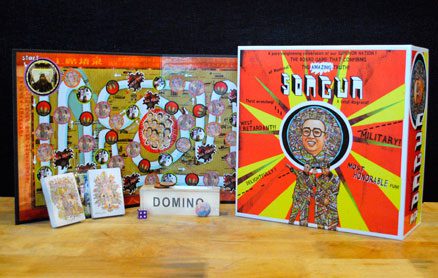 Rumpus: I agree, and I’m thinking now about what you just said about Purple Rain—as soon as you threw out that title, I immediately saw the album cover in my mind’s eye. I’m not sure young kids today have that visual vocabulary—at least not connected to music.
Rumpus: I agree, and I’m thinking now about what you just said about Purple Rain—as soon as you threw out that title, I immediately saw the album cover in my mind’s eye. I’m not sure young kids today have that visual vocabulary—at least not connected to music.
Barnes: Right. That’s sad.
Rumpus: And even now that vinyl is coming back it’s still not returned to being the standard way that people listen to music. Big boxes like Target, Best Buy, and Bed Bath & Beyond are carrying some titles but probably not too many beyond prefabricated pop hits and the obvious reissues…
Barnes: [Laughs] I’m trying to imagine Keith Richards finding an old blues record he’s looking for in Bed Bath & Beyond!
Rumpus: The person who’s picking up some records with their sheets and towels probably isn’t the same person who’s going to spend hours browsing in an independent record store. For you and Kevin, how much of a factor in designing of Montreal’s albums is the merchandising?
Barnes: The visual is so closely tied to the music for us, and it just brings Kevin and me so much joy to work together—me getting new songs from him and him getting new images from me. 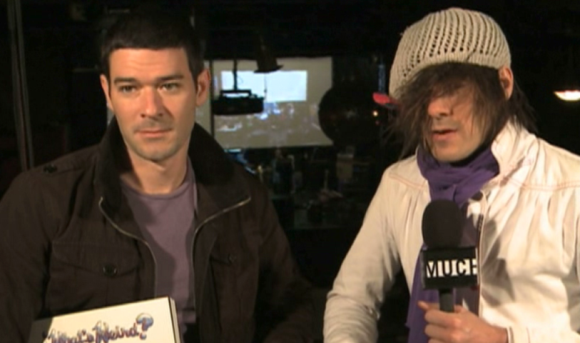 And I think if you go in the opposite way—forget about the packaging—you’ll still get some people interested, but most people who buy our records are buying vinyl now. It’s not just a delivery mechanism or merchandising—it’s something they can have. The immediacy of a digital stream or download is nice, but it’s not the same as having something physical.
And I think if you go in the opposite way—forget about the packaging—you’ll still get some people interested, but most people who buy our records are buying vinyl now. It’s not just a delivery mechanism or merchandising—it’s something they can have. The immediacy of a digital stream or download is nice, but it’s not the same as having something physical.
Rumpus: It seems very important to you that the art you make is tangible, has meaning. Are you always thinking about new ways to bring of Montreal’s music to life?
Barnes: Yes. My mom is kind of a hoarder of stuff—like knockoffs of little ceramic sculptures, like maybe an 18th century kid skipping—and I’m finding them in thrift stores and painting over them and changing them completely so they’re the characters from the album artwork. And I’m thinking about selling them at shows at the merch table as a true one-of-a-kind souvenir.
Rumpus: Let’s talk more about the band’s live show. When you’re planning a tour how do you approach the visuals and the kinds of skits, etc. that you perform?
Barnes: First we toss out a lot of ideas and then you figure out what’s possible. Like we might say “How about tigers on stage!” and then we realize, “Oh, that may not work”—but maybe we can animate that. We try to do a new show every four shows, and if a new album comes out that’s when we scrap everything and start from scratch with costumes, animations, etc. A tour may go for like three months, and then one of my favorite things is a little satellite that comes after that where we have all of this stuff and come up with new ways of using it. It’s more like what I do with my drawings, where I might say, “Oh, I have this mirror suit and I have this pig mask and they’re used for different things. I’m going to put the pig head on the mirror. Then he’s going to fall in love with the Princess Leia character from this scene…”
Rumpus: How did you come up with the title for your book ¿What’s Weird? and what was it like to choose from among this vast repertoire of characters and images?
Barnes: When I was young, in middle school, people would say, “You’re weird!” I hated it so much. Then they’d say something like, “Ooh! A squid! That’s weird!” It’s not weird. It’s just a fact. I also know a little Spanish—just enough to know the upside down question mark captures that idea. For the images, I went on instinct. It was like I’ll have to make a decision… like a worm with a sloth face, that’s stupid. But a bear with a goat head, no, that’s good! I’ll keep that one!
Rumpus: You’ve also extended that idea to defamiliarize iconic food packaging, grocery ads, and to chronicle the misadventures of a “bad baby.” Can you tell me more about that?
Barnes: Bad baby is a “Martha Pullan original”—that’s what my mom calls it. It’s a doll made by this sewing guru that my mom gave to my brother’s daughter as a gift. But one day when my niece was little she walked into her bedroom and she saw the doll move and it freaked her out so much that the next morning she and Kevin were at my door with the doll in a paper bag and she asked me if it could live at my house instead. Since then it’s become a sort of good luck charm that comes on every tour with us and gets up to no good.
Rumpus: Do you have a dream project that you haven’t been able to pursue yet?
Barnes: Yes, I have this graphic novel idea that’s been in my brain so long, in so many different forms. It’s about a pregnant male football player. Half of it is his story and the other half is about the baby growing inside his womb in this fantastic world, basically moving toward birth. The idea is that the fetus isn’t just sitting there growing. Inside their minds are already forming—they say babies come out with a certain disposition—so this is what’s playing out in his head as he’s growing. They get born and forget everything, but when the guy in the gas station turns his back and the kid grabs a candy bar, it’s probably because in the womb he was already practicing by stealing the treasure from the dragon!
Rumpus: And you’re actually expecting a baby in real life, right?
Barnes: Yes!
***
This interview has been edited and condensed. If you’d like to recommend someone for “Sound & Vision,” drop Allyson a line here.
***
All photographs courtesy of David Barnes/Polyvinyl.

